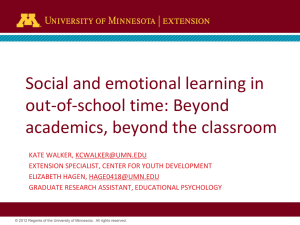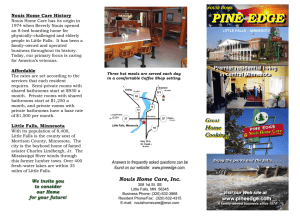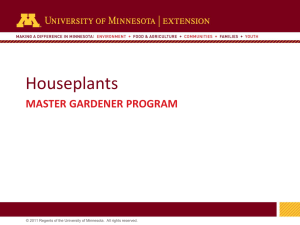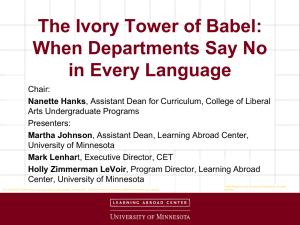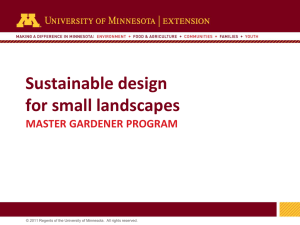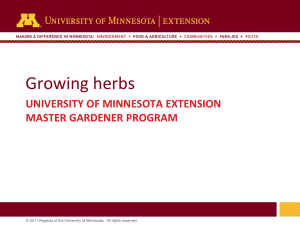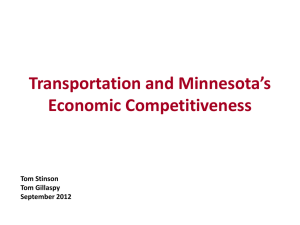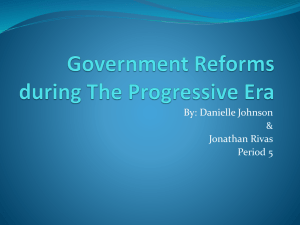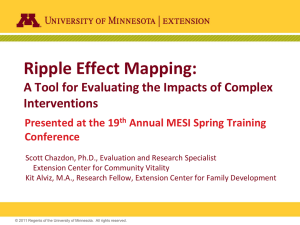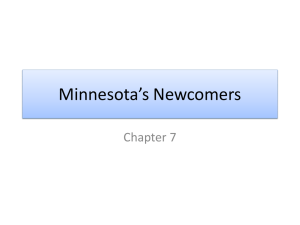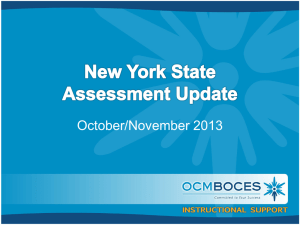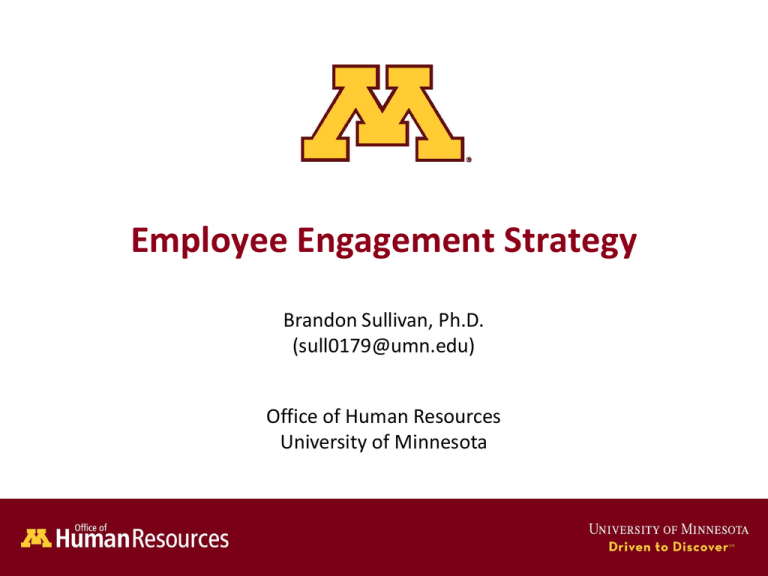
Employee Engagement Strategy
Brandon Sullivan, Ph.D.
(sull0179@umn.edu)
Office of Human Resources
University of Minnesota
Overview
• Replacing the Pulse survey with an employee engagement process
•
Brief survey: 20-25 items, 5-10 minutes to complete
•
Focused on key drivers of a happy, productive workplace
•
Customized reports distributed quickly to leaders at all levels
•
Action-planning tools and support
•
Includes faculty and staff system-wide
• Faculty advisory committee and stakeholder interviews informing design
• Enhancing supervisor training and leadership development
Timeline
Oct ’13
• Survey administration
Nov – Dec ’13
• Analyze results and
prepare reports
Jan ’14
• Executive presentations
• Online reports available
© 2013 Regents of the University of Minnesota. All rights reserved.
2
Feb – May ’14
• Action-planning
Why should I care?
Imagine two Universities…
• Both have talented, hard-working, passionate faculty and staff and wellrespected, highly ranked programs
• However, some differences have emerged
• At one of these universities…
• Turnover of top talent is going up
• Productivity of faculty and staff is dropping
• Students and community stakeholders are less happy
• Goals are being scaled back
What does the future look like?
© 2013 Regents of the University of Minnesota. All rights reserved.
3
Why should I care?
What is going on here?
Why are faculty and staff at one university more likely to stay, willing to
work harder, more productive, and delivering better service to students and
the community?
It’s NOT about money…
… it’s about engagement
© 2013 Regents of the University of Minnesota. All rights reserved.
4
What Research and Practice Tell Us
What is engagement? Passion and dedication to collective excellence
and wellbeing
Why is it important? Engagement profoundly shapes the quality of experiences
and outcomes in the workplace
• Recruiting, retaining, and developing top talent
• Resilience and wellbeing
• Collaboration and innovation
• Performance and productivity
What creates engagement? Commitment to each others’ success, willingness
to invest time and energy to transform good into great, and being empowered
to do your best work
© 2013 Regents of the University of Minnesota. All rights reserved.
5
What Research and Practice Tell Us
• Engagement is driven LOCALLY
• Leaders create the foundation for engagement through motivating
others toward common goals and providing support to enable success
Gallup findings (Lopez, 2013)
Does your leader at work make you enthusiastic about the future?
80%
60%
40%
69%
Engaged
20%
1%
0%
Yes
No
© 2013 Regents of the University of Minnesota. All rights reserved.
6
What Research and Practice Tell Us
Critical questions
• Will my efforts
contribute to
something meaningful?
• Do I believe that our
leaders are capable
and effective?
• Is the environment
supportive and
respectful?
• Can I grow and
develop here?
Emotional
commitment
Personal
investment
• I am proud of my
contributions
• I care about the future
of my organization
• I am aware of my
strengths and
development needs
• I am willing to improve
• I push myself to do
great work
• I go out of my way to
help my coworkers and
colleagues succeed
Creating motivation
Where leaders make the difference
Empowerment
Results
• Clear roles and
responsibilities
• Resources and support
to succeed
• Autonomy
• Effective collaboration
• Administrative
efficiency
• Job fit
• Training to close
skill gaps
• Wellbeing
• Retention / turnover
• Productivity
and performance
• Overall organizational
effectiveness
Enabling success
Where individuals make the difference
• Research at the University of Minnesota found that the drivers of
engagement are also hallmarks of our most research-productive departments
(Bland, Weber-Main, Lund, & Finstad, 2005)
© 2013 Regents of the University of Minnesota. All rights reserved.
7
Action-Planning Framework
Online Reports
and ActionPlanning
Support
Executive
Presentations
and Consulting
Academic
Units
Administrative
Units
Process and Resources
•
Provost and
Deans
Vice-Presidents
•
•
Executive presentation of results for leader’s
full organization
Individual team report for leader’s direct team
Consulting support for action-planning
Chairs and
Heads
Directors,
Managers, and
Supervisors
•
•
•
•
Roll-up report for department (for leaders-of-leaders)
Individual team report for leaders’ direct team
Online action-planning tool and resources
Consulting support as-needed
President and Chancellors
Survey Content (20-25 items)
Key Metrics
Key Drivers
• Engagement index
• Creating emotional commitment
and personal investment
• Intention to stay (turnover risk)
• Empowering individuals to do their best work
• Inclusiveness
© 2013 Regents of the University of Minnesota. All rights reserved.
8
Today
Mar – Apr
2013
May –
June 2013
Timeline
July – Aug
2013
Strategizing and Planning
Sept – Oct
2013
Nov – Dec
2013
Analyzing
Communicating
Jan – Feb
2014
Mar – Apr
2014
Presenting & Action Planning
May –
June 2014
July – Aug
2014
Reviewing & Updating
Survey Administration
Finalize strategy
Select survey tool
Create and deliver executive presentations;
support action planning
Socialize strategy
Design survey
& reporting
Clean and load
data; testing
Develop marketing strategy and total
communication plan
Analysis,
reporting
Review and update
strategy for 2014-15
Online reports and actionplanning; ad hoc reporting
Implement marketing campaign and communication plan for each
phase (e.g., administration, reporting, action-planning)
Create leadership development tools and process
for action-planning phase
Testing,
finalizing
Implement development tools and process
Ongoing consulting on engagement; supporting related projects and initiatives
© 2013 Regents of the University of Minnesota. All rights reserved.
9
Begin to link to
org outcomes
Detailed Timing of Reporting
Survey administration
Create executive
presentations
Presentation to President
• U of M faculty and staff across all campuses complete survey
• Created in collaboration with college and unit HR teams and OHR consultants
• Includes recommended action steps
• Total University results, highlighting key wins and focus areas
• Intended to provide a high-level overview of results
Oct 2013
Nov - Dec 2014
Jan 2014
• Presentation of total University results
Jan – Feb 2014
Presentations to
Chancellors, Deans, VPs
• College, unit, and campus-level results
• Key wins, opportunities, recommended action-plans and next steps
Jan – Feb 2014
Online reports available
to all leaders
• Online reports for leaders
• Leaders share results and involve their teams in creating an action-plan
• Leaders of leaders hold their DRs accountable for follow-through on process
Jan – Feb 2014
• Present relevant results to governance groups
(e.g., Faculty, P&A, Civil Service senates)
Feb – April 2014
• Support provided by college and unit HR teams and OHR consultants
• Follow-up / deep-dive analysis as needed
Mar – May 2014
Board of Regents
Present to key committees
Finalize action plans
for senior leaders
President shares results
with U community
• President shares wins, developmental focus areas, action plan
© 2013 Regents of the University of Minnesota. All rights reserved.
10
TBD
Supplemental Information
© 2013 Regents of the University of Minnesota. All rights reserved.
11
Key Drivers of Engagement
Creating Motivation
Enabling Success
• Build a shared vision for the future
• Inspire each other to go above and
beyond what is expected
• Consistently recognize and value
good work
• Listen actively and seek to understand
others’ viewpoints
• Show concern and support for each
others’ wellbeing
• Help each other make progress toward
professional and career goals
• Ensure roles and responsibilities are
clear and agreed upon
• Close gaps in resources needed
for success
• Eliminate micro-management and
empower individuals to make decisions
• Identify meaningful ways to enhance
teamwork and collaboration
• Address pain points in administrative
processes and eliminate “red tape”
• Ensure people are in the right jobs
and provide training to close skill gaps
• Research at the University of Minnesota found that the drivers of
engagement are also hallmarks of our most research-productive departments
(Bland, Weber-Main, Lund, & Finstad, 2005)
© 2013 Regents of the University of Minnesota. All rights reserved.
12


